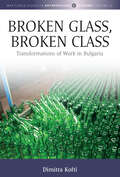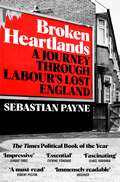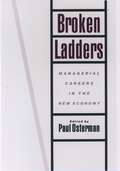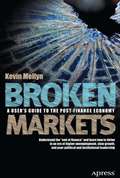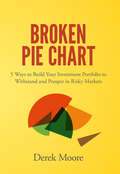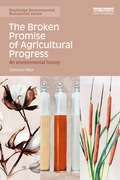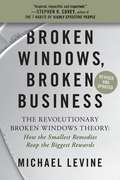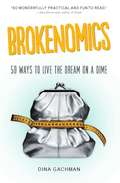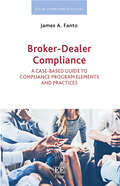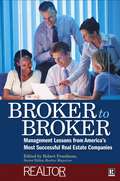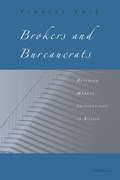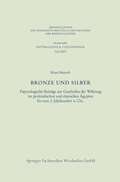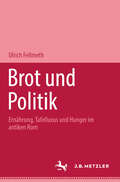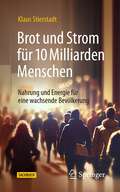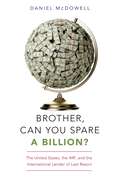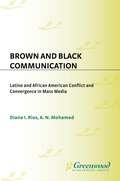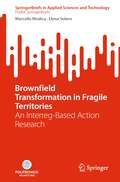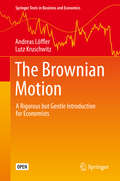- Table View
- List View
Broken Glass, Broken Class: Transformations of Work in Bulgaria (Max Planck Studies in Anthropology and Economy #12)
by Dimitra KoftiBased on a long-term study of the everyday postsocialist politics of labour in the wider context of intense socio-economic transformation in Bulgaria, this book tells the story of the flexibilization of production, the precaritization of work, shifting managerial practices, and ways in which people with different employment statuses live and work together. The ethnography starts with the rapidly moving conveyor belt of a glass factory, where a variety of global and local forces and workers’ divisions meet, and analyses how inequalities are reproduced both at the production site and back home.
Broken Glass, Broken Class: Transformations of Work in Bulgaria (Max Planck Studies in Anthropology and Economy #12)
by Dimitra KoftiBased on a long-term study of the everyday postsocialist politics of labour in the wider context of intense socio-economic transformation in Bulgaria, this book tells the story of the flexibilization of production, the precaritization of work, shifting managerial practices, and ways in which people with different employment statuses live and work together. The ethnography starts with the rapidly moving conveyor belt of a glass factory, where a variety of global and local forces and workers’ divisions meet, and analyses how inequalities are reproduced both at the production site and back home.
Broken Heartlands: A Journey Through Labour's Lost England
by Sebastian Payne'A must-read for anyone who wants to understand England today' - Robert PestonBroken Heartlands is an essential and compelling political road-trip through ten constituencies that tell the story of Labour’s red wall from Sebastian Payne – an award-winning journalist and Whitehall Editor for the Financial Times.Historically, the red wall formed the backbone of Labour’s vote in the Midlands and the North of England but, during the 2019 general election, it dramatically turned Conservative for the first time in living memory, redrawing the electoral map in the process.Originally from the North East himself, Payne sets out to uncover the real story behind the red wall and what turned these seats blue. Beginning in Blyth Valley in the North East and ending in Burnley, with visits to constituencies across the Midlands and Yorkshire along the way, Payne gets to the heart of a key political story of our time that will have ramifications for years to come.While Brexit and the unpopularity of opposition leader Jeremy Corbyn are factors, there is a more nuanced story explored in Broken Heartlands – of how these northern communities have fared through generational shifts, struggling public services, de-industrialization and the changing nature of work. Featuring interviews with local people, plus major political figures from both parties – including Boris Johnson and Sir Keir Starmer – Payne explores the significant role these social and economic forces, decades in the making, have played in this fundamental upheaval of the British political landscape.'Broken Heartlands is the product of rich reporting on the ground . . . Payne tells many stories of many places and people with affection and respect, to weave a picture of the changing political fabric of England' - Laura Kuenssberg
Broken Ladders: Managerial Careers in the New Economy
by Paul OstermanBroken Ladders: Managerial Careers in the New Economy provides the first comprehensive view of how the careers of managers in organizations are changing. Broken Ladders reports on the employment security, advancement prospects, skills, and wages of managers in a wide range of firms and industries. These cases show that one myth--that the number of managers is declining--is wrong. But the job tenure of middle managers is more precarious. They can no longer expect steady promotions up the ladder, nor can they expect life-time employment with the same firm. New organizational designs demand new skills from managers and Broken Ladders describes what these are. On another front, managerial pay has not declined at the same rate as other workers. However, the pay gap between senior and middle managers has widened. Given job insecurity and growing pay inequality firms confront a difficult dilemma: how to maintain the commitment of their managers at the same time that the employers are reducing their commitment to their employees. Broken Ladders will be of interest to scholars and students in the fields of human resources, labor economics, career development, and organizational behavior. It will also be important reading for managers and strategic planners who have to take account of the changing nature of employment.
Broken Markets: A User's Guide to the Post-Finance Economy
by Kevin Mellyn"I would sleep better if I knew that Bernanke, Geithner, Bachus, Sen. Tim Johnson, Obama and Romney all kept dog-eared copies of Kevin Mellyn's Broken Markets on their nightstands. . . . Mellyn's work is a fascinating, important, and eminently good read and should inform the debate on overhauling the U.S. and global financial regulatory systems and sustainable macro fiscal and monetary policy." --Eric Grover, in his review of Broken Markets in The American Banker Broken Markets allows the intelligent non-specialist to understand and navigate the ongoing worldwide aftermath of the 2008 financial market meltdown. The key theme of the book is how the leading financial institutions and the political leadership of the U.S. and European Union have failed us and set the stage for continued market turmoil. It explains what this means for investors, borrowers, society in general, and the financial-services industry. Former banker Kevin Mellyn focuses on providing readers with clear and simple explanations of the forces at work and the potential consequences for their future prosperity. As this book makes clear, what’s coming is a world in which high structural unemployment and flat or declining real income is likely—not to mention a diminished retirement financial safety net. The book therefore provides actionable information for protecting wealth and making prudent investment decisions in an economy that is nothing like the one that has sustained us for decades. As a forward-looking narrative about rapidly changing events and volatile markets and politics, Broken Markets will provide no single prediction about the future but rather describe alternative scenarios and provide the reader with signposts to watch out for in deciding which reality is actually unfolding. Unlike most books written by journalists on global finance, the scenarios and signposts described will be largely based on the lessons of financial and political history rather than breaking news. This book: Tells you in plain language how today’s financial system threatens your livelihood and wealth Tells you why and how governments worldwide, with some notable exceptions, are taking actions likely to make things worse instead of better Explains how the leading financial institutions lost their way during the bubble years and how they can find the path back to prosperity and value to society Tells you what life will be like in a “post-finance” economy and how you can protect your wealth
Broken Pie Chart: 5 Ways to Build Your Investment Portfolio to Withstand and Prosper in Risky Markets
by Derek MooreInvestment outcomes and strategies have changed considerably since 2008. Broken Pie Chart demonstrates the failures of classical diversification and asset allocation, pointing out that the backward-looking methods used by traditional financial professionals will not work moving forward. Derek Moore explains why traditional risk-spreading leads to losses during sell-off periods, and contains risks that many investors do not recognize until it is too late. He also reflects on the changes in the financial market since the global financial crisis, and how these changes may affect your asset allocation and risk management decision-making in a landscape of lower rates and higher risks. With this work, readers can take a fresh look at their portfolios by identifying the emerging asset classes that will lead to investment success, using effective financial strategies to enhance their position, and placing smart floors, hedges and buffers to minimize risk.
Broken Pie Chart: 5 Ways to Build Your Investment Portfolio to Withstand and Prosper in Risky Markets
by Derek MooreInvestment outcomes and strategies have changed considerably since 2008. Broken Pie Chart demonstrates the failures of classical diversification and asset allocation, pointing out that the backward-looking methods used by traditional financial professionals will not work moving forward. Derek Moore explains why traditional risk-spreading leads to losses during sell-off periods, and contains risks that many investors do not recognize until it is too late. He also reflects on the changes in the financial market since the global financial crisis, and how these changes may affect your asset allocation and risk management decision-making in a landscape of lower rates and higher risks. With this work, readers can take a fresh look at their portfolios by identifying the emerging asset classes that will lead to investment success, using effective financial strategies to enhance their position, and placing smart floors, hedges and buffers to minimize risk.
The Broken Promise of Agricultural Progress: An Environmental History (Routledge Environmental Humanities)
by Cameron MuirFood and the global agricultural system has become one of the defining public concerns of the twenty-first century. Ecological disorder and inequity is at the heart of our food system. This thoughtful and confronting book tells the story of how the development of modern agriculture promised ecological and social stability but instead descended into dysfunction. Contributing to knowledge in environmental, cultural and agricultural histories, it explores how people have tried to live in the aftermath of ‘ecological imperialism’. The Broken Promise of Agricultural Progress: An environmental history journeys to the dry inland plains of Australia where European ideas and agricultural technologies clashed with a volatile and taunting country that resisted attempts to subdue and transform it for the supply of global markets. Its wide-ranging narrative puts gritty local detail in its global context to tell the story of how cultural anxieties about civilisation, population, and race, shaped agriculture in the twentieth century. It ranges from isolated experiment farms to nutrition science at the League of Nations, from local landholders to high profile moral crusaders, including an Australian apricot grower who met Franklin D. Roosevelt and almost fed the world. This book will be useful to undergraduates and postgraduates on courses examining international comparisons of nineteenth and twentieth century agriculture, and courses studying colonial development and settler societies. It will also appeal to food concerned general readers.
The Broken Promise of Agricultural Progress: An Environmental History (Routledge Environmental Humanities)
by Cameron MuirFood and the global agricultural system has become one of the defining public concerns of the twenty-first century. Ecological disorder and inequity is at the heart of our food system. This thoughtful and confronting book tells the story of how the development of modern agriculture promised ecological and social stability but instead descended into dysfunction. Contributing to knowledge in environmental, cultural and agricultural histories, it explores how people have tried to live in the aftermath of ‘ecological imperialism’. The Broken Promise of Agricultural Progress: An environmental history journeys to the dry inland plains of Australia where European ideas and agricultural technologies clashed with a volatile and taunting country that resisted attempts to subdue and transform it for the supply of global markets. Its wide-ranging narrative puts gritty local detail in its global context to tell the story of how cultural anxieties about civilisation, population, and race, shaped agriculture in the twentieth century. It ranges from isolated experiment farms to nutrition science at the League of Nations, from local landholders to high profile moral crusaders, including an Australian apricot grower who met Franklin D. Roosevelt and almost fed the world. This book will be useful to undergraduates and postgraduates on courses examining international comparisons of nineteenth and twentieth century agriculture, and courses studying colonial development and settler societies. It will also appeal to food concerned general readers.
Broken Windows, Broken Business: The Revolutionary Broken Windows Theory: How the Smallest Remedies Reap the Biggest Rewards
by Michael LevineNow revised and updated, this "inspired, impactful, and important" book shows how to achieve the ultimate success by rectifying the small problems that can sink a business (Stephen R, Covey, author of The 7 Habits of Highly Effective People).Once every few years a book comes along with an insight so penetrating, so powerful—and so simply, demonstrably true—that it instantly changes the way we think and do business. Such a book is Broken Windows, Broken Business, a breakthrough in management theory that can alter the destiny of countless companies striving to stay ahead of their competition.In this vital work, author Michael Levine offers compelling evidence that problems in business, large and small, typically stem from inattention to tiny details. Social psychologists and criminologists agree that if a window in a building is broken and left unrepaired, soon thereafter the rest of the windows will be broken—and the perception will build that crime in that neighborhood is out of control. The same principle applies to business.Drawing on real-world corporate examples, from JetBlue's decision to give fliers what they really want—leather seats, personal televisions, online ticketing - to Google's customer-based strategy for breaking out of the pack of Internet search engines, to business-to-business firms' successes and failures, Levine proves again and again how constant vigilance and an obsession with detail can make or break a business or a brand.With tips and advice on changing any business to one that dots its i's, crosses its t's, and attracts more clients, Broken Windows, Broken Business goes straight to the heart of what makes all enterprises successful—the little things that mean a lot.
Broken Windows, Broken Business: How the Smallest Remedies Reap the Biggest Rewards
by Michael LevineNow revised and updated, this "inspired, impactful, and important" book shows how to achieve the ultimate success by rectifying the small problems that can sink a business (Stephen R, Covey, author of The 7 Habits of Highly Effective People).Once every few years a book comes along with an insight so penetrating, so powerful—and so simply, demonstrably true—that it instantly changes the way we think and do business. Such a book is Broken Windows, Broken Business, a breakthrough in management theory that can alter the destiny of countless companies striving to stay ahead of their competition.In this vital work, author Michael Levine offers compelling evidence that problems in business, large and small, typically stem from inattention to tiny details. Social psychologists and criminologists agree that if a window in a building is broken and left unrepaired, soon thereafter the rest of the windows will be broken—and the perception will build that crime in that neighborhood is out of control. The same principle applies to business.Drawing on real-world corporate examples, from JetBlue's decision to give fliers what they really want—leather seats, personal televisions, online ticketing - to Google's customer-based strategy for breaking out of the pack of Internet search engines, to business-to-business firms' successes and failures, Levine proves again and again how constant vigilance and an obsession with detail can make or break a business or a brand.With tips and advice on changing any business to one that dots its i's, crosses its t's, and attracts more clients, Broken Windows, Broken Business goes straight to the heart of what makes all enterprises successful—the little things that mean a lot.
Brokenomics: 50 Ways to Live the Dream on a Dime
by Dina GachmanIn Brokenomics, author Dina Gachman shares the lessons she’s learned about how to live large in the cheap seats. Through stories both painfully honest and laugh-out-loud funny that anyone can relate to, Dina reveals all the tricks you need to live the good life without spending a ton of money.Brokenomics covers the place where economics and everyday life collide. It includes:Rules for changing your mindset ("There Will Always Be Someone Richer, Taller, Smarter, and Better Looking Than You”)Wise words about making big decisions, like raising children-or not ("Why Have a Baby When You Can Just Get a Nice Potted Plant?”)Clear-eyed relationship advice ("Do Not Date Anyone Who Loves Their Bong More Than They Love You”)Solid guidance for renters ("The Freeloader's Guide to Housesitting”)And strategies for talking to your honey about money. . . without breaking upThis helpful and hilarious handbook has the answers for crafting your own version of the glamorous life without breaking the bank. Dina shares advice on every page while keeping things fresh, light, and fun. Written with the wisdom afforded by hindsight, Brokenomics will appeal to recent college grads, newly committed couples, and those facing career crises alike.
Broker-Dealer Compliance: A Case-based Guide to Compliance Program Elements and Practices (Elgar Compliance Guides)
by James A. FantoBroker-Dealer Compliance is a concise yet comprehensive guide that reviews the state of broker-dealer compliance, both from general and practical perspectives. While the book has a practical focus, it also makes use of legal scholarship and behavioral and organizational literature on compliance that have grown exponentially in recent years.James Fanto discusses the main, well-established elements and practices in a broker-dealer compliance program and illustrates them with case studies and practical examples drawn from real-life situations to demonstrate the goals of a particular program element and problems in its implementation. Moreover, each chapter highlights the pressures on compliance officers and the trends that collectively may transform compliance practice in a particular area.Professionals in broker-dealer and investment firm compliance practice will find this book a readable introduction to the field. Experienced practitioners can refresh their knowledge and even learn something new about brokerage compliance program elements and practices.
Broker to Broker: Management Lessons From America's Most Successful Real Estate Companies
by Realtor MagazinePraise for Realtor? Magazine's BROKER to BROKER "By providing best practice management tips with thought-provoking ideas, Broker to Broker offers invaluable guidance on virtually every aspect of our dynamic industry. The book's easy-to-read format, with in-depth supporting material available online, is an innovative approach to helping the country's brokers and managers find effective solutions to today's challenges." --Ron Peltier, President and CEO, HomeServices of America, Inc., Minneapolis, Minnesota "This compilation of the latest Realtor? Magazine articles on real estate brokerage management could be of help to brokers and managers looking for practical ideas to boost their operations. The book quotes extensively from veteran brokers and managers who are trying new ways to build sales and tackle problems. Within the book's range of articles could be helpful ideas for you." --J. Lennox Scott, Chairman and CEO, John L. Scott Real Estate, Seattle, Washington "The editors did their homework. The pace of change in our business is a constant challenge. Even if you don't want to lead the charge in industry change, brokers would do well to study the innovative concepts (such as the employee-agent model) illustrated here. The section on operations is particularly useful for brokers of a multi-office/multi-region operation." --Steve Brown, ABR?, CRB, Vice President and General Manager, Crye-Leike, Realtors?, Memphis, Tennessee "The editors of Realtor? Magazine do a fantastic job of keeping Realtors? on top of all real estate concerns. No issue is more timely or essential to building good business than brokerage practices." --Blanche Evans, Publisher, Agent News, and Editor, Realty Times, Dallas, Texas
Brokers and Bureaucrats: Building Market Institutions in Russia
by Timothy M. FryeA classic problem of social order prompts the central questions of this book: Why are some groups better able to govern themselves than others? Why do state actors sometimes delegate governing power to other bodies? How do different organizations including the state, the business community, and protection rackets come to govern different markets? Scholars have used both sociological and economic approaches to study these questions; here Timothy Frye argues for a different approach. He seeks to extend the theoretical and empirical scope of theories of self-governance beyond groups that exist in isolation from the state and suggests that social order is primarily a political problem. Drawing on extensive interviews, surveys, and other sources, Frye addresses these question by studying five markets in contemporary Russia, including the currency futures, universal and specialized commodities, and equities markets. Using a model that depicts the effect of state policy on the prospects for self-governance, he tests theories of institutional performance and offers a political explanation for the creation of social capital, the formation of markets, and the source of legal institutions in the postcommunist world. In doing so, Frye makes a major contribution to the study of states and markets. The book will be important reading for academic political scientists, economists (especially those who study the New Institutional Economics), legal scholars, sociologists, business-people, journalists, and students interested in transitions. Timothy Frye is Assistant Professor of Political Science, The Ohio State University.
Bronze und Silber: Papyrologische Beiträge zur Geschichte der Währung im ptolemäischen und römischen Ägypten bis zum 2. Jahrhundert n. Chr. (Abhandlungen der Nordrhein-Westfälischen Akademie der Wissenschaften #25)
by Klaus MareschBrot und Politik: Ernährung, Tafelluxus und Hunger im antiken Rom
by Ulrich FellmethWenn die Getreidelieferungen aus den Provinzen ausblieben, wurde es für 95 Prozent der Bevölkerung des antiken Rom eng; nur eine dünne Oberschicht konnte den sprichwörtlichen Tafelluxus der Römer zelebrieren. Die Ernährungsgewohnheiten, die Hungerkrisen mit ihren Ursachen und Konsequenzen und die Reaktionen der Politik sind Thema dieses Buches.
Brot und Strom für 10 Milliarden Menschen: Nahrung und Energie für eine wachsende Bevölkerung
by Klaus StierstadtWie lange liefert die Sonne genug Energie für unsere wachsende Bevölkerung?Reichen unsere Dächer aus, um genügend Solarstrom zu erzeugen?Stellen Pflanzen und Algen genug Nahrung und Sauerstoff für alle Lebewesen bereit?Millionen Menschen hungern. Strom ist für Milliarden Menschen ein Traum oder zumindest ein Luxusgut. Dieses Buch diskutiert mit Hilfe verständlich dargestellter Physik, wie weit es zu wenig Ressourcen gibt und wie weit es schlicht ein Problem der Verteilung ist.Das Buch ist gleichermaßen geeignet für Interessierte wie für Personen mit physikalischer Ausbildung. Zahlreiche Vergleiche und Erklärungen zeichnen ein anschauliches Bild, welches durch viele Abschätzungen und physikalische Details ergänzt wird.
Brother, Can You Spare a Billion?: The United States, the IMF, and the International Lender of Last Resort
by Daniel McDowellConventional wisdom says that the International Monetary Fund (IMF) functions as the de facto international lender of last resort (ILLR) for the global financial system. However, that premise is incomplete. Brother, Can You Spare a Billion? explores how the U.S. has for decades regularly complemented the Fund's ILLR role by selectively providing billions of dollars in emergency loans to foreign economies in crisis. Why would the U.S. ever put national financial resources at risk to "bail out" foreign countries? McDowell argues that the U.S. has been compelled to provide such rescues unilaterally when it believes the IMF's multilateral response is too slow or too small to protect vital U.S. economic interests. Through a combination of historical case studies and statistical analysis, McDowell uncovers the defensive motives behind U.S. decisions to provide global liquidity from the 1960s through the 2008 global financial crisis. Moving beyond conventional wisdom, this book paints a complete picture of how international financial crises have been managed and highlights the unique role the U.S. has played in stabilizing the world economy in troubled times.
Brother, Can You Spare a Billion?: The United States, the IMF, and the International Lender of Last Resort
by Daniel McDowellConventional wisdom says that the International Monetary Fund (IMF) functions as the de facto international lender of last resort (ILLR) for the global financial system. However, that premise is incomplete. Brother, Can You Spare a Billion? explores how the U.S. has for decades regularly complemented the Fund's ILLR role by selectively providing billions of dollars in emergency loans to foreign economies in crisis. Why would the U.S. ever put national financial resources at risk to "bail out" foreign countries? McDowell argues that the U.S. has been compelled to provide such rescues unilaterally when it believes the IMF's multilateral response is too slow or too small to protect vital U.S. economic interests. Through a combination of historical case studies and statistical analysis, McDowell uncovers the defensive motives behind U.S. decisions to provide global liquidity from the 1960s through the 2008 global financial crisis. Moving beyond conventional wisdom, this book paints a complete picture of how international financial crises have been managed and highlights the unique role the U.S. has played in stabilizing the world economy in troubled times.
Brown and Black Communication: Latino and African American Conflict and Convergence in Mass Media (Contributions to the Study of Mass Media and Communications)
by Diana Rios Ali MohamedThough Latinos and African Americans have lived together in large cities as neighbors, there is much that is still misunderstood between them. Those who live in non-diverse locales have only news and entertainment representations on which to base their information about the two cultures. This new collection of essays brings together the latest interdisciplinary works by scholars examining conflicts and convergences among Latinos and African Americans in mass-mediated and cross-cultural contexts. Contributions in the form of both empirical and critical ethnographic research present compelling works in cross-cultural relations, news, entertainment, news media, education, and community relations.^IBrown and Black Communication^R challenges those who do not think that significant projects and key research have been conducted on the two largest ethnic communities in the United States. Of certain appeal to both scholars and those with more applied needs in media, education, and public policy, this challenging collection offers a range of perspectives on two widely diverse bodies of American people.
Brownfield Transformation in Fragile Territories: An Interreg-Based Action Research (SpringerBriefs in Applied Sciences and Technology)
by Marcello Modica Elena SoleroThis book presents and critically evaluates the results of a European territorial cooperation project addressing the planning challenge of brownfield transformation in fragile territories. Set against the backdrop of the current scenario of deindustrialisation in the European Alps, the book describes how to read and interpret the spatial condition of industrial brownfields in peripheral mountain areas as complex transformation sites. Through key theoretical references, well-documented experiences and field activities, the book explores and advances an innovative methodology of design-based participatory planning conceived specifically for fragile socioeconomic and environmental contexts. The empirical basis for such a methodological exploration is provided by four pilot sites distributed between Austria, Italy, France and Slovenia, identified in the cooperation project as highly representative and recurring situations. The book includes a comparative review of the work carried out for the pilot sites, as well as the planning outcomes generated, providing a clear and operative reference for scholars, professionals and public officers called to face similar experiences.
Brownian Agents and Active Particles: Collective Dynamics in the Natural and Social Sciences (Springer Series in Synergetics)
by Frank SchweitzerThis book lays out a vision for a coherent framework for understanding complex systems. By developing the genuine idea of Brownian agents, the author combines concepts from informatics, such as multiagent systems, with approaches of statistical many-particle physics. It demonstrates that Brownian agent models can be successfully applied in many different contexts, ranging from physicochemical pattern formation to swarming in biological systems.
The Brownian Motion: A Rigorous but Gentle Introduction for Economists (Springer Texts in Business and Economics)
by Andreas Löffler Lutz KruschwitzThis open access textbook is the first to provide Business and Economics Ph.D. students with a precise and intuitive introduction to the formal backgrounds of modern financial theory. It explains Brownian motion, random processes, measures, and Lebesgue integrals intuitively, but without sacrificing the necessary mathematical formalism, making them accessible for readers with little or no previous knowledge of the field. It also includes mathematical definitions and the hidden stories behind the terms discussing why the theories are presented in specific ways.
